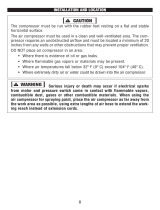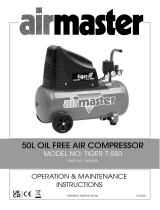
5
Silent Air Series
Basic Guidelines
1. Allow only trained, authorized persons who
have read and understood these operating
instructions to use this compressor. Failure
to follow the instructions, procedures and
safety precautions in this manual can result in
accidents and injuries.
2. NEVER start or operate the compressor
under unsafe conditions. Tag the compressor,
disconnect and lock out all power to it to
prevent accidental start-up until the condition
is corrected.
3. Install, use and operate the compressor only
in full compliance with all pertinent OSHA
regulations and all applicable Federal, State &
Local Codes, standards and regulations.
4. NEVER modify the compressor and/or
controls in any way.
5. Keep a rst aid kit in a convenient place. Seek
medical assistance promptly in case of injury.
Avoid infection by caring for any small cuts
and burns promptly.
Breathable Air
1. NEVER use air from this compressor for
breathable air except in full compliance with
OSHA Standards 29 CFR 1910 and any other
Federal, State or Local codes or regulations.
Death or serious injury can result
from inhaling compressed air
without using proper safety
equipment. See OSHA standards
on safety equipment.
2. DO NOT use air line anti-icer systems
in air lines supplying respirators or other
equipment used to produce breathable air.
DO NOT discharge air from these systems in
unventilated or other conned areas.
Pressurized Components
1. This equipment is supplied with a ASME
designed pressure vessel protected by an
ASME rated relief valve. Pull the ring before
each use to make sure the valve is functional.
DO NOT attempt to open valve while the
machine is under pressure.
2. Improper maintenance could lead to the air
tank bursting or exploding.
3. Drain air tank after each use or
daily to prevent moisture buildup in the
air tank. Rust can weaken the air tank
and cause leaks or bursting. If rust is
detected, replace tank immediately.
4. Do not attempt repairs to the air tank by
welding, drilling or other modications. Such
modications may weaken the air tank and
cause a hazardous condition.
5. If the air tank develops a leak, replace it
immediately. Never repair, weld or make
modications to the air tank or its attachments.
6. Do not make adjustments to the factory-set
pressures.
7. Never exceed attachments' manufacturer's
maximum-allowable pressure rating.
8. Do not use plastic pipe or lead tin solder
joints for a discharge line as the may not
withstand the high heat developed during air
compression.
Personal Protective Equipment
Be sure all operators and others around the
compressor and its controls comply with all
applicable OSHA, Federal, State and local
regulations, codes and standards relating to
personal protective equipment. This includes
respiratory protective equipment, protection for
the extremities, protective clothing, protective
shields and barriers, electrical protective
equipment, and personal hearing protective
equipment.
1. Eye protection should be worn at all times
when operating this tool. Use ANSI approved
safety glasses. Everyday eyeglasses are NOT
safety glasses. Dust mask, non-skid safety
shoes, hard hat, or hearing protection should
be used in appropriate conditions.
2. Wear proper apparel.
Loose clothing, gloves, neckties, rings,
bracelets, or other jewelry may present a
potential hazard when operating this tool.
Please keep all apparel clear of the tool.
Inspection
Inspect compressor prior to any use. Check for
external damage that might have occurred during
transit. Be careful of moving parts. Report any
damage to delivery carrier immediately.
Do not operate unit if damaged
during shipping, handling or use.
Damage may result in bursting and cause injury
or property damage.
Installation
Area
1. Install compressor in a clean, dry and well-lit
area. Be sure installation area can maintain a
temperature range between 35° - 110° F (2° -
43° C).
If ambient temperature drops
below 32˚F (0° C), be sure to
protect safety/relief valves and drain valves from
freezing. NEVER operate compressor with
temperatures below 15˚F (-9.5° C) or above 125˚F
(52° C).
2. Allow sucient space around compressor for
maintenance access and adequate airow.
Mount unit leaving a minimum of 15 inches (38
cm) of clearance.

























